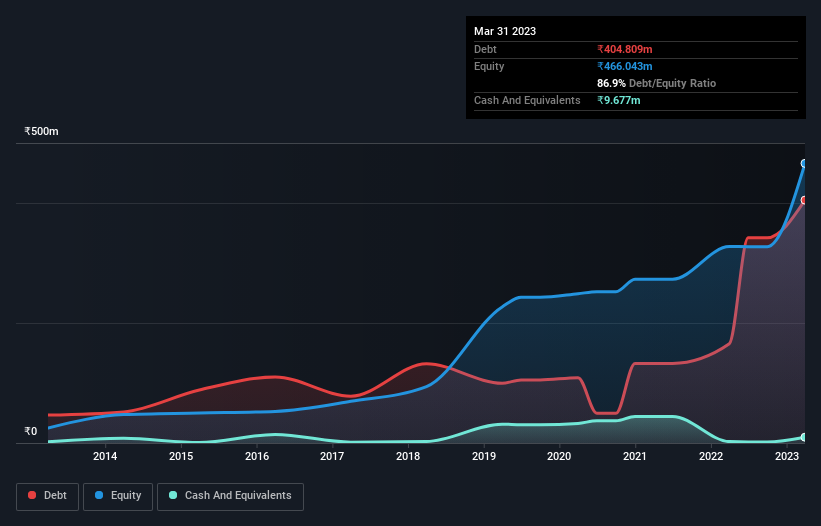
Some say volatility, rather than debt, is the best way to think about risk as an investor, but Warren Buffett famously said that 'Volatility is far from synonymous with risk.' So it seems the smart money knows that debt - which is usually involved in bankruptcies - is a very important factor, when you assess how risky a company is. We note that Ushanti Colour Chem Limited (NSE:UCL) does have debt on its balance sheet. But the real question is whether this debt is making the company risky.
What Risk Does Debt Bring?
Debt assists a business until the business has trouble paying it off, either with new capital or with free cash flow. In the worst case scenario, a company can go bankrupt if it cannot pay its creditors. However, a more common (but still painful) scenario is that it has to raise new equity capital at a low price, thus permanently diluting shareholders. Having said that, the most common situation is where a company manages its debt reasonably well - and to its own advantage. The first thing to do when considering how much debt a business uses is to look at its cash and debt together.
View our latest analysis for Ushanti Colour Chem
What Is Ushanti Colour Chem's Debt?
As you can see below, at the end of March 2023, Ushanti Colour Chem had ₹404.8m of debt, up from ₹165.4m a year ago. Click the image for more detail. However, it also had ₹9.68m in cash, and so its net debt is ₹395.1m.

How Healthy Is Ushanti Colour Chem's Balance Sheet?
The latest balance sheet data shows that Ushanti Colour Chem had liabilities of ₹247.5m due within a year, and liabilities of ₹288.6m falling due after that. Offsetting this, it had ₹9.68m in cash and ₹265.8m in receivables that were due within 12 months. So it has liabilities totalling ₹260.6m more than its cash and near-term receivables, combined.
While this might seem like a lot, it is not so bad since Ushanti Colour Chem has a market capitalization of ₹619.1m, and so it could probably strengthen its balance sheet by raising capital if it needed to. But it's clear that we should definitely closely examine whether it can manage its debt without dilution. When analysing debt levels, the balance sheet is the obvious place to start. But you can't view debt in total isolation; since Ushanti Colour Chem will need earnings to service that debt. So when considering debt, it's definitely worth looking at the earnings trend. Click here for an interactive snapshot.
Over 12 months, Ushanti Colour Chem made a loss at the EBIT level, and saw its revenue drop to ₹440m, which is a fall of 7.8%. That's not what we would hope to see.
Caveat Emptor
Over the last twelve months Ushanti Colour Chem produced an earnings before interest and tax (EBIT) loss. Indeed, it lost ₹17m at the EBIT level. Considering that alongside the liabilities mentioned above does not give us much confidence that company should be using so much debt. Quite frankly we think the balance sheet is far from match-fit, although it could be improved with time. Another cause for caution is that is bled ₹248m in negative free cash flow over the last twelve months. So in short it's a really risky stock. The balance sheet is clearly the area to focus on when you are analysing debt. However, not all investment risk resides within the balance sheet - far from it. Case in point: We've spotted 6 warning signs for Ushanti Colour Chem you should be aware of, and 5 of them are a bit unpleasant.
If, after all that, you're more interested in a fast growing company with a rock-solid balance sheet, then check out our list of net cash growth stocks without delay.
New: AI Stock Screener & Alerts
Our new AI Stock Screener scans the market every day to uncover opportunities.
• Dividend Powerhouses (3%+ Yield)
• Undervalued Small Caps with Insider Buying
• High growth Tech and AI Companies
Or build your own from over 50 metrics.
Have feedback on this article? Concerned about the content? Get in touch with us directly. Alternatively, email editorial-team (at) simplywallst.com.
This article by Simply Wall St is general in nature. We provide commentary based on historical data and analyst forecasts only using an unbiased methodology and our articles are not intended to be financial advice. It does not constitute a recommendation to buy or sell any stock, and does not take account of your objectives, or your financial situation. We aim to bring you long-term focused analysis driven by fundamental data. Note that our analysis may not factor in the latest price-sensitive company announcements or qualitative material. Simply Wall St has no position in any stocks mentioned.
About NSEI:UCL
Ushanti Colour Chem
Manufactures and sells chemicals, dyes, and intermediates in India.
Slight and overvalued.
Similar Companies
Market Insights
Community Narratives




